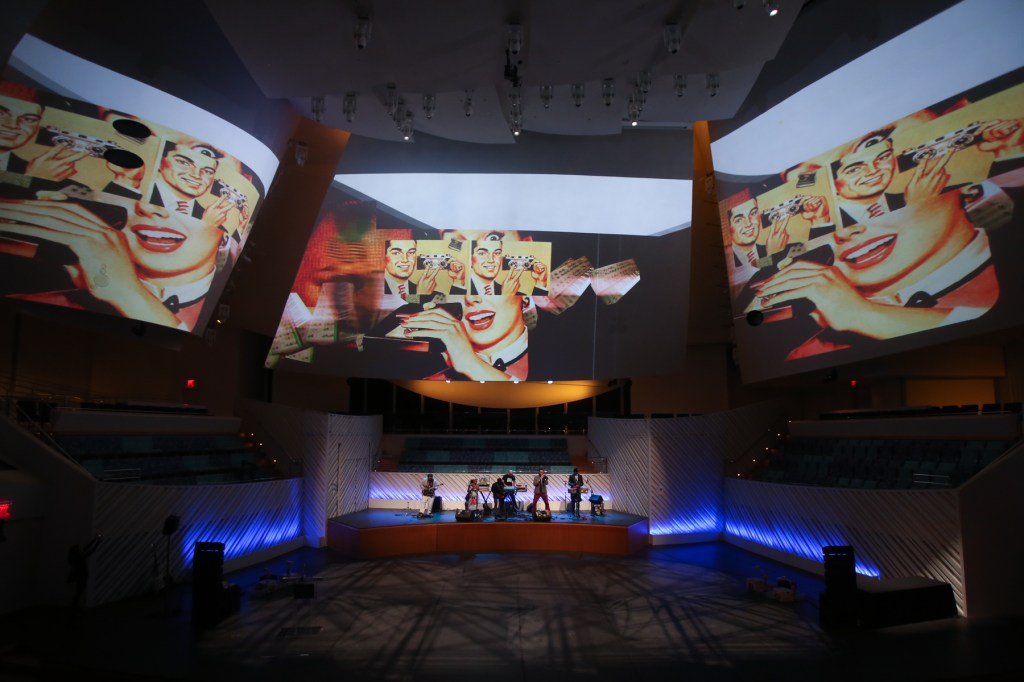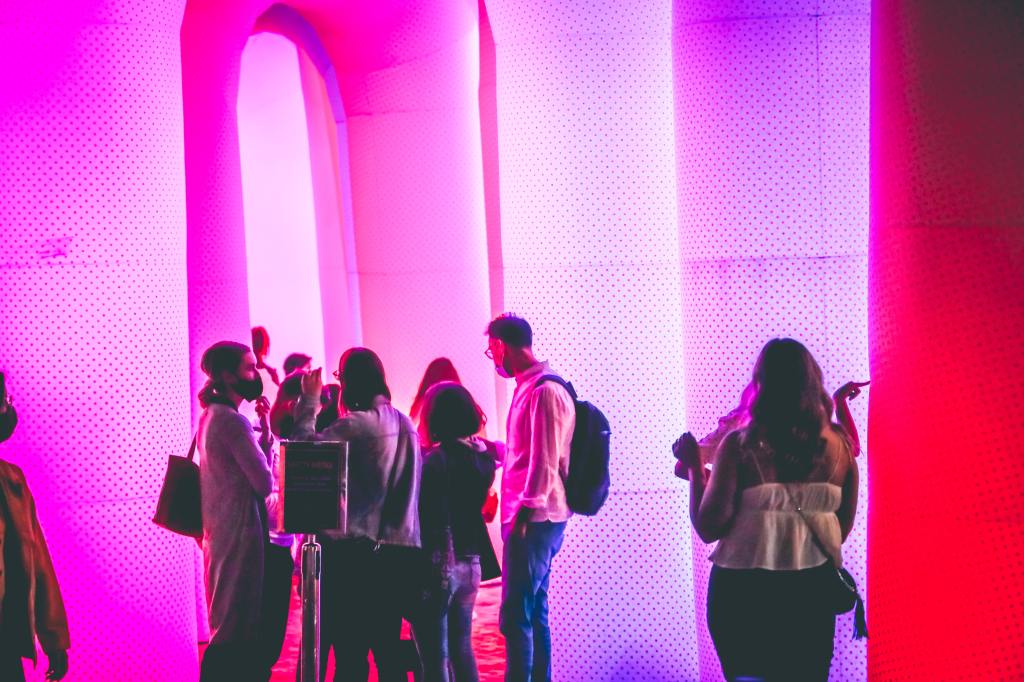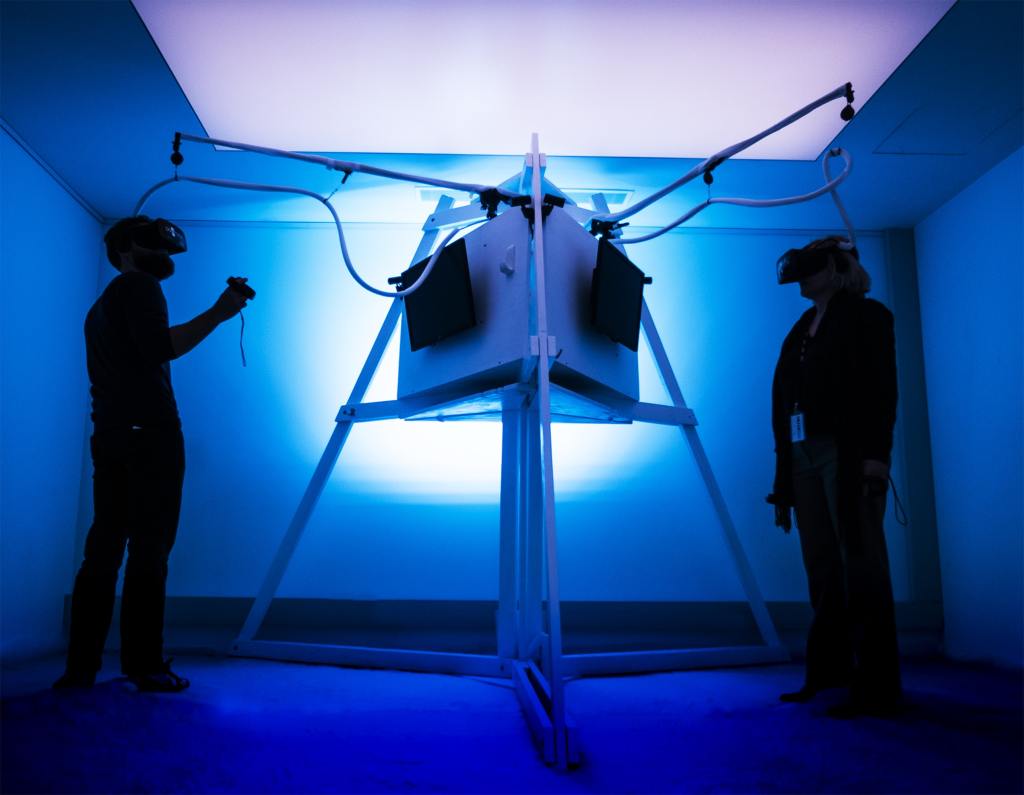Social Practice Art That Is in Plain Sight but You Dont Always See It
Gallery visitors with completed Fundreds at McColl Heart for Art + Innovation.
Social exercise art, often also called interactive fine art or participatory art, in some way encourages the viewer to engage straight with the art or artist by either forcing viewers' physical actions, manipulating their senses, or sharing artistic expression with them. This type of fine art has been on the rising since the 1970s, with much earlier precedents similar the Surrealists hands-on events in Paris; the "Happenings" of Allan Kaprow in the 1950s and '60s; the feminist art of Miriam Schapiro and Judy Chicago in "Womanhouse"; or Graciela Carnivale's "Experimental Art Cycle."
Nonetheless, social practice art has become more than mainstream with college art programs even offering concentrations in social practise. This popularity is hardly surprising given the "plugged in" nature of our culture and our habitual interactivity. Social practice art appeals to u.s.. Why it appeals to artists as a mode of artistic practise may seem more obscure.
Much of these artworks are aimed at raising awareness of social and environmental problems, alleviating these weather condition, and empowering people to create alter. The noble intentions of social practice artists with activist goals cannot exist dismissed as hyperbole.
Proponents of social practice fine art suggest that artists choose this method in rejection of the art marketplace. The imperceptible nature of much of this artwork with fiddling salable material supports this argument. Furthermore, this choice may be a reaction against the excesses of individualism. Modern art upheld individual expression as the pinnacle of artistic endeavour, so a swing away from this seems reasonable in gimmicky fine art.
A contempo chat I had with multimedia installation creative person Samantha Hill nearly practicing what she terms "experiential art" supports these arguments. "I'm interested in these philosophical discussions and interpretations of culture," she said, "but I'm doing it in the fine art realm. I throw out a question to start a dialog. Experiential fine art allows me to ask more questions and learn nearly people – to connect with more people."
Hill's art exercise is very much focused outward to listen and engage with the globe around her, significantly rejecting modern fine art'south obsession with individual expression. Her work is multi-disciplinary, combining oral history, archival work, multimedia installations, public interaction and performance. Colina's latest piece of work, "The Kinship Project," is an annal of 145 years of family photography, oral history recordings, artifacts and ephemera. She uses this collection as source material for social engagement installations like "The Jeli's Tale: An Anthology of Kinship" and "The Great Migration" at the Southside Hub of Production in Chicago.
Furthermore, Hill wants to share buying of her site-specific installations, viewing them about every bit science experiments where she can stride back and meet what happens. "My way of creating is to permit the projection unfold. It volition depend on the participants I interview and photo. Information technology's well-nigh them. My installations are experiential to activate all five senses at once, and so I also desire the viewers to take buying of my projects. Have a conversation with each other. Get by the gallery etiquette and touch on the art."
Experiential art is also an respond to today'due south applied science centered globe proclaimed Colina: "People need a different kind of activation considering we are stimulated past so much media we don't even know how to call back straight, and so we need something to go us hyper focused. Yous can actuate people with a lot of tactile stimuli."
For Colina, the end goal is the chat – the interaction between people: "I like to play. I similar to play a lot, and when I make something that is interactive, I am in the process of playing. So by allowing my audience to participate in the work with me it is like we are all on the playground learning a new game together."
Samantha Hill completed a residency at the McColl Eye for Art + Innovation in November 2013. While in Charlotte, she worked with the residents of Double Oaks neighborhood, which is being converted to Brightwalk, a planned mixed income housing community, to capture their memories and stories of the neighborhood, besides as its transformation. In mid- to tardily 2015, Loma will return to Charlotte and employ this cloth, much of which she captured with a tintype camera, to create an interactive installation in a historic location Downtown.
Social practice art is conspicuously popular, since it has spread beyond the "art capitals" of New York City, Paris and London. Here in the Queen City, nosotros accept had multiple opportunities of belatedly to participate in social do art with the residences of Samantha Hill, Quynh Vantu and Mel Chin at the McColl Eye. Who that created a Fundred Dollar Bill could forget the empowerment that came from this type of democratic expression through art? "Functioning Paydirt/Fundred Dollar Bill" is scheduled for completion this year, with all of the Fundreds to be delivered to Washington, D.C., where this art currency volition promote solutions to the atomic number 82 contamination of cities.
Vantu's "Thresholds," which re-imagined the first-floor gallery and entrance of the McColl Center using fabric and light, made participants out of passive visitors. Equally you walked through "Thresholds," the installation forced y'all to physically act and move in certain ways because of its construction, and then with the addition of other people in the same space, you had to negotiate how to act and move with them and the installation. Vantu is vested in exploring the social interaction that occurs with and considering of the built surroundings. The active and unique space of a threshold recurs in Vantu'due south art, every bit it is this space where people are frequently moving in and out that enhances social engagement.

Quynh Vantu "Thresholds" at the McColl Centre.
As the introductory characterization to the exhibition put it: "In midst of this technological age, digital networks and virtual realms are beingness constructed at a staggering rate. It enables and subsequently rewards our nigh insular and private impulses. Qunyh Vantu'southward "Thresholds" serves to gracefully guide the states dorsum to a tangible reality through a series of shared experiences with ourselves and a community."
This type of interaction between people is at the heart of social practice art. Artists like Colina and Vantu are facilitating personal encounters – something we seem to have lost or devalued in the "plugged in" atmosphere we inhabit. Ironically, the tools that were supposed to use to create greater connection have increased altitude – we adopt the impersonal nature of an email to the timbre of a voice over the phone. Hill, Vantu, Chin and other social exercise artists are reacting against this altitude to promote more confront-to-face up interaction, conversation and connexion.
Some critics label these artworks equally too experiential and imply that they are superficial, bordering on amusement. They suggest this only feeds into a culture obsessed with experiences. Merely, maybe, this is better than a culture obsessed with materialism. Some experiences created by social practice art might exist frivolous, simply the majority I take participated in are not. They create connectedness, and isn't a meaningful experience what art is all about?
Contempo Content
Source: https://knightfoundation.org/articles/whats-up-with-social-practice-art/



0 Response to "Social Practice Art That Is in Plain Sight but You Dont Always See It"
Post a Comment